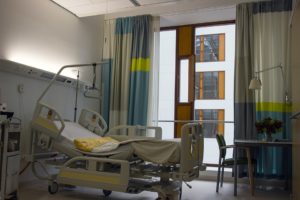
The following is a review by one of our fellows, Dr. Randy McCreery, who at a recent journal club presented a paper by Johnson, et al.: Effectiveness of Oral Vancomycin for Prevention of Healthcare Facility-Onset Clostridioides difficile Infection in Targeted Patients During Systemic Antibiotic Exposure, Clinical Infectious Diseases, 28 September 2019.
In addition, Drs. McCreery, Cawcutt, Cortes-Penfield & Van Schooneveld published a letter to the editor of Clinical Infectious Diseases based on this journal club review and blog post. Read the official letter here. A formal reply to this letter, was also published here.
Why was it important to review this article?
This article attempts to address an important question: with nearly 500,000 infections and 15,000 deaths annually (CDC) attributed to Clostridioides difficile, how might we further reduce the incidence of this disease beyond the antimicrobial stewardship and infection control procedures that we are already employing? To date, most of the data on chemoprophylaxis for preventing Clostridioides difficile infections (CDI) is retrospective, and thus, more prospective, randomized data is needed. This article not only provides important new data from a prospective randomized trial, but it also provides a summary of the available retrospective data to date.
Who did they study?
Admitted patients who were felt to be high risk for developing healthcare facility onset CDI were studied. High risk was based upon age (> 60), recent hospitalization (< 30 days), and recent and current use of antibiotics (during the prior and current hospitalization).
What did they do and where did they do it?
Patients were enrolled over a 7-month period at a single, 961-bed, tertiary hospital in Winston-Salem, North Carolina, in a prospective, randomized, open-label study. One hundred high risk patients were randomized, 50 in each arm, to receive either oral vancomycin prophylaxis (OVP) or no prophylactic therapy. OVP was given for the duration of systemic antibiotic therapy plus an additional 5 days at a dose of 125 mg daily. Patients received an average of 12 days of OVP.
What did they find?
They found that 6 patients in the control arm developed healthcare facility onset CDI (the primary end point) vs none in the prophylactic arm, and this was statistically significant (p = 0.03).
Key points from the article:
- The article attempts to answer an important question, but drawing definitive conclusions from this trial remains difficult.
- The screening method used in this study to identify patients at high risk of developing CDI may not perform similarly in all institutions. Thus, the external validity of this study remains questionable.
- The trial was small and without a placebo arm, both of which can be a source of bias.
- Randomization of small numbers of patients may not evenly distribute important risk factors. While the authors argue that the imbalances in risk factors in this study, mainly high-risk antibiotic exposure, likely favored development of more CDI in the prophylaxis group thus strengthening their conclusion that OVP can prevent CDI, a larger trial with more balanced exposures would present a clearer picture as to the true effect of OVP in preventing CDI.
- Related to the lack of a placebo, nowhere in the article does it account for how many tests for CDI were run in either group nor the number of patients in each group that developed diarrhea. These are important data to include because they are the components of the primary end point. Differences in these data between groups may have been due to procedural bias due to a lack of placebo and blinding of both patients and healthcare personnel leading to differences in the primary outcome.

- The definition of healthcare facility onset CDI did not include a toxin assay. Given that CDI is a toxin mediated disease, toxin reporting (or PCR cycle time that predicts toxin as has been recently reported by Senchyna et al.) may have been able to distinguish disease from colonization in the control group. This calls into question the method by which the primary outcome measurement was made. Is it possible that given no toxin assay was performed in the control group, that only colonization was detected, and diarrhea was present for another reason? Is it possible that colonization would have been detected in the OVP group had the vancomycin not decreased colonization causing PCR assays to be negative?
- New VRE colonization was evaluated as a secondary endpoint. While no patients in the OVP arm were found to have new VRE colonization, there was a baseline colonization rate of 42%, and 36% of patients in the OVP group were not tested. With such a high rate of baseline colonization and so many patients that did not undergo analysis, the study design is likely underpowered to detect any meaningful difference in conversion from VRE negative to VRE positive in the OVP group. The control group should also be tested to account for any baseline conversion rates. This metric was not reported either.
- Telephone surveys completed post-discharge were low, < 50% in each arm making any conclusions related to outcomes beyond the hospital stay challenging to assess.
- No information was included regarding how many patients were screened versus the number enrolled. The algorithm to identify those eligible was simple and did not seem excessively restrictive. The exclusion criteria may have made many who were started on antibiotics at admission difficult to enroll because the expiration time for starting OVP (< 72hrs after antibiotic initiation) would lapse at or near the time the patients became eligible for enrollment (admitted for > 72 hrs). If this was the case, the authors should say so in addition to any other reason why it took 7 months to enroll 106 patients in a 961-bed hospital.
- OVP also seemed to be well tolerated
- Cost estimates were quite favorable in the OVP group with around $26 per prophylactic course. With a number needed to treat of 9, that would equate to an average of $236 to prevent one case of CDI. That was compared to the authors estimate of $2,648 in additional hospital costs per episode of hospital onset CDI.
Conclusion:
While this study demonstrated less positive PCR tests in the OVP group, the lack of key clinical data makes the conclusion limited and inadequate to inform active clinical practice. The jury remains out on the efficacy of OVP pending a larger, randomized, ideally placebo controlled, multicenter study.
Steven W Johnson, Shannon V Brown, David H Priest, Effectiveness of Oral Vancomycin for Prevention of Healthcare Facility-Onset Clostridioides difficile Infection in Targeted Patients During Systemic Antibiotic Exposure, Clinical Infectious Diseases, , ciz966, https://doi.org/10.1093/cid/ciz966